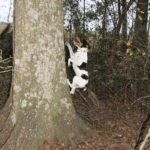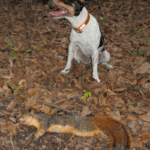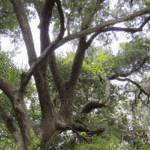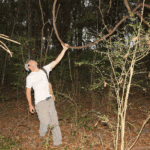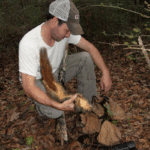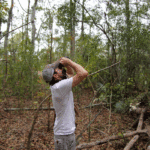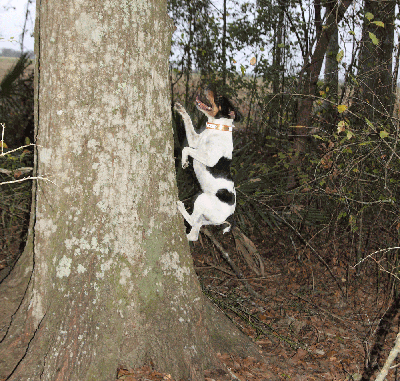
The month of February makes feeding a squirrel dog all year well worth it.
Somewhere inside the small patch of woods surrounded by sugarcane fields, Hoke hunted. Maybe no more than 20 acres in size, if you flew over it the woodland would resemble a postage stamp stuck in the middle of an envelope.
A mix of hackberry, swamp maple, water and pin oaks, the isolated habitat wasn’t large enough to support a deer population, but it’s perfect for big red fox squirrels.
Hoke was used to the terrain, having hunted it before. There’d be no surprises on the afternoon. The goal was simply to spend a couple of hours hunting on a day already short because of winter, and if all went well the day would culminate with shooting a couple of the tree dwellers for the pot.
The trick was letting Hoke do all the work first; our job would begin after he treed.
Hoke, a Jack Russell terrier, didn’t waste any time, late in the day like it was. For most hunting dogs, rest comes after sunset.
Soon the little dog’s bark echoed through the canopy of trees, like a solo coming from a New York amphitheater to alert us he’d done his job.
It was now time for us to do ours.
Matthew McCollister, a wildlife refuge specialist at Mandalay National Wildlife Refuge, is a dog man. Besides Hoke, McCollister doesn’t own any other canines — or trained many for that matter. But has always enjoyed hunting with anyone who does.
Hoke happens to suit his current lifestyle as a biologist, not requiring all the care and needs of larger dogs.
McCollister introduced me to “The Ben Lilly Legend,” written by J. Frank Dobie and published in 1952, when he and I first met. Lilly, a late 19th and early 20th century bear and panther hunter from North Louisiana, also was a dog man.
That initial meeting led to our afternoon in the squirrel woods.
I told McCollister I had never hunted squirrels with a dog.
“What a travesty!” he replied.
Hoke’s bark intensified, while we made our way to the treed squirrel. But the constant trip hazards from fallen dead branches entangled in trumpet creeper and the net-like cobwebs strung by garden spiders, presented barriers to a speedy arrival.
Maybe they were just my barriers since McCollister, a lean and slender young man in his late 20s, was ahead of me, darting in and out of the underbrush seemingly having little problem.
My heart rate was increased. The sweatband in my cap began getting moist. And heat from my forehead fogged up my glasses.
This wasn’t one of Lilly’s bears or panthers, but I was no less excited to reach the tree.
Somehow the squirrel was able to do a disappearing act.
“When Hoke sees a squirrel, his tone will change,” McCollister said. “If he sees a squirrel bail out and go tree to tree, he’ll go to squeaking, and his bark really intensifies.
“But usually I find the empty trees are my fault. At first, when Hoke was young and hadn’t established himself yet, I had a lot of doubts. I didn’t have enough faith in him. But now, if the conditions are right and I’ve got people looking, almost always there’s one up that tree or within another tree’s reach.”
McCollister intently studied the tall pin oak for several minutes, coming to the conclusion the nests in the tree were probably the salvation of our bushytailed quarry, and we were too late getting there.
Hoke was insistent that we just weren’t looking adequately, and ran several feet up the side of the tree trying to assure us we were wrong.
McCollister called Hoke off, commanding him to “Hunt ’em up!”
It only took giving the command once, and Hoke was off in search of another squirrel.
Squirrel dogs, like any other breed of hunting dogs, require obedience training and a consistent regimen to instill what their owners require.
Jack Russells are independent, can be headstrong, often bark excessively and require lots of exercise due to their desire to run. In short, they love the chase, making squirrel hunting the ideal release for their pent-up energy.
“Hoke is pretty obedient and easy to catch,” McCollister said. “I find lots of people want an awesome dog, but they want to buy it. Squirrel hunting with a dog like Hoke gives me a chance to get out once or twice during the week. Plus, I feel obligated; Hoke motivates me to be more active.”
Hoke treed again. Only this time we were there in short order. The water oak that Hoke was literally trying to climb included two of McCollister’s key essentials to be considered a good setup with high probability to score a bushytail — an open view and a vine to pull on.
Once again, we studied the tree canopy, looking for the squirrel. Hoke was adamant. The squirrel was up there somewhere.
McCollister pulled out a pair of binoculars, and scoured each and every limb, not finding a trace of fur.
“Get ready,” McCollister said as he pulled on the vine to shake the tree’s upper limbs.
Suddenly, the squirrel burst from out of nowhere and was leaping across the upper canopy. It was too quick for my reflexes, and I couldn’t get a bead on it.
It wasn’t too quick for McCollister, who fired and dropped the big fox squirrel to the ground.
“No matter what, when you come up to a tree, the squirrel is already hiding,” McCollister said. “It’s how much is it going to take to move the squirrel?
“He made one mistake. If he didn’t, he’d have lived. The best tree situation is where the tree has an open field of view and a vine hanging from it.”
That perfect setup isn’t always what hunters find.
“(E)very tree it’s a different,” McCollister said. “Sometimes the squirrel will run. Sometimes it will freeze if it’s been shot at before and knows what a dog is. And I’ve also seen it where an old squirrel will be going full tilt trying to get out of the tree.
“They’ll hit the ground running and have a den somewhere in mind that they are running to.”
McCollister mentioned that squirrels are often hard to pattern. On windy days, it’s assumed squirrels have been on the ground and the dog is treeing off of pooled scent from their activity beneath the tree. On colder days, the dog will often tree, but hunters won’t see anything; the dog simply might be doing its best trying to utilize very little information, therefore, marking a lot of empty trees.
Just before dark, Hoke treed one last time. The tree was open, with large branches with several bends, a couple of notches and very few leaves — a perfect scenario.
Once again McCollister broke out his binoculars and looked over the canopy. With each passing moment, the understory was getting darker and darker as the sun was setting on our wooded amphitheater.
“Got him!” McCallister said, as he pointed to a crooked branch and asked if I see him.
“No, I can’t see him,” I replied.
Handing me his binoculars and pointing to a heavy branch McCollister said described the squirrel’s hiding place,
“Follow that branch and right where it bends he’s laying there flat,” he said. “I can see just the tip of his tail.”
Sure enough, there it was. I could see the tail. Perhaps only a couple of inches gave the squirrel away.
“Find you a place you have a clear shot, and I’ll go to the other side,” McCollister said. “It might run to your side, where you can get a shot.”
The squirrel never budged as my partner got into position.
From his side of the tree McCollister said he could see a bit more of the little animal.
“I can see a little bit of its shoulder, I’m going to shoot,” he said.
The shotgun’s report sounded like someone shot the inside of a 55-gallon drum the way it bounced off the tree canopy and onto the forest floor, where layers of leaves absorbed and quickly deadened it.
Meanwhile the squirrel was going for broke, leaping to another branch, when I shot.
Not sure whether it was McCollister’s shot or mine that ended the squirrel’s life, it was with great satisfaction I watched Hoke muzzle the fox squirrel to make sure it was dead.
“We can walk up to a tree and search with four people and we’re probably going to find that squirrel,” McCollister said. “But in a place that’s hunted a good bit, a squirrel is going to learn real quick to hold real tight no matter what, kind of like this one did.”
Late-season squirrel hunting, where leaves are sparse and food resources have them searching the ground, is an excellent time to be in the woods. But when you’re chasing the critters, hoping to bring a couple home to put in the pot, there’s nothing like a Jack Russell barking up the right tree to help you find them.
